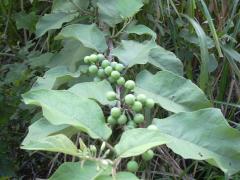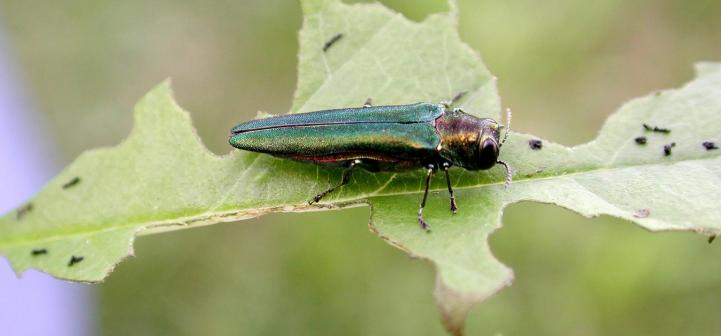Invasive Species: Solanum torvum, Turkey Berry
Turkey berry is a broadleaved, evergreen shrub or small tree that invades a variety of ecosystems in Florida. Plants can grow to 16 ft. (4.9 m) in height. The stems are armed with stout, straight, or lightly curved prickles. The alternate leaves are elliptical, 10 in. (25 cm) long, have prickles along the midvein, and star-shaped hairs underneath. Leaves range from unlobed to strongly lobed. The small, white flowers occur in large, branched clusters. Plants flower continuously after reaching a height of 3.3 to 4.9 ft. (1 to 1.5 m). Fruit are small, yellow berries. Although turkey berry has only been found several times in Florida, it has the potential to invade a variety of sites, both wet and dry. Once established, it can sprout from the roots, creating large thickets that could displace native vegetation. Turkey berry is found throughout the world’s tropical regions and was introduced into Florida sometime before 1900 for cultivation trials.
What are invasive species and why should we be concerned about them?
Taxonomy: Scientific and Common Names for This Species
Solanales > Solanaceae > Solanum torvum Swartz
Synonym(s): devil’s fig, turkeyberry
Solanum torvum – USDA PLANTS Profile
Distribution Maps
Turkey berry – The reported distribution of this invasive species across the United States (Source: Invasive Plant Atlas of the United States)
Up-to-the-minute distribution maps and why they are important
Reporting This Invasive Species
What is the best way and place to report the occurrence of an invasive species?
How to report an invasive species sighting to EDDMapS – Early Detection & Distribution Mapping System
EDDMapS – Report an invasive species to EDDMapS.
Cooperative Extension Offices – Find your local Cooperative Extension office on this map provided by USDA.
How to Identify
This invasive species can be identified by looking for the characteristics described in the paragraphs that follow.
Shrub
Turkey berry is a broadleaved, evergreen shrub or small tree can grow to 16 ft. (4.9 m) in height. The stems are armed with stout, straight, or lightly curved prickles.
 |
 |
| Forest & Kim Starr, Starr Environmental, bugwood.org | Forest & Kim Starr, Starr Environmental, bugwood.org |
Foliage
The alternate leaves are elliptical, 10 in. (25 cm) long, have prickles along the midvein, and star-shaped hairs underneath. Leaves range from unlobed to strongly lobed.
 |
 |
| Forest & Kim Starr, Starr Environmental, bugwood.org | Forest & Kim Starr, Starr Environmental, bugwood.org |
Flower
The small, white flowers occur in large, branched clusters. Plants flower continuously after reaching a height of 3.3 to 4.9 ft. (1 to 1.5 m).
 |
 |
| Forest & Kim Starr, Starr Environmental, bugwood.org | Florida Division of Plant Industry Archive, Florida Department of Agricultre and Consumer Services, bugwood.org |
Fruit
Fruit are small, yellow berries.
 |
 |
| Forest & Kim Starr, Starr Environmental, bugwood.org | Julia Scher, USDA APHIA PPQ, bugwood.org |
Native Species That Can Resemble Turkey Berry
– Images at invasive.org
| bugwood.org | bugwood.org |
– Images at invasive.org
| bugwood.org | bugwood.org |
Additional Images for Turkey Berry
Turkey berry – Images at Invasive.org
Additional Information, Biology, Control and Management Resources
Control and management recommendations vary according to individual circumstances. Location, habitat, weather, and a variety of other conditions are factors that help determine the best treatment choice. To find the safest and most effective treatment for your situation, consult your state’s land-grant institution. If you will use chemicals as part of the control process, always refer to the product label.
United States Land-Grant University System – Find your land-grant university’s college of agriculture, Cooperative Extension office, or other related partner on this map provided by USDA.
Biological Control of Invasive Plants in the Eastern United States – USDA Forest Service
Federal Noxious Weed Disseminules of the U.S. – USDA-APHIS
Images and Information – University of Florida – Center for Aquatic and Invasive Plants
